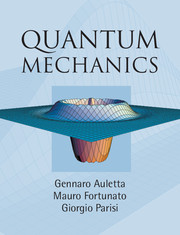Book contents
- Frontmatter
- Contents
- List of figures
- List of tables
- List of definitions, principles, etc.
- List of boxes
- List of symbols
- List of abbreviations
- Introduction
- Part I Basic features of quantum mechanics
- Part II More advanced topics
- 6 Angular momentum and spin
- 7 Identical particles
- 8 Symmetries and conservation laws
- 9 The measurement problem in quantum mechanics
- Part III Matter and light
- Part IV Quantum information: state and correlations
- Bibliography
- Author index
- Subject index
8 - Symmetries and conservation laws
Published online by Cambridge University Press: 05 June 2012
- Frontmatter
- Contents
- List of figures
- List of tables
- List of definitions, principles, etc.
- List of boxes
- List of symbols
- List of abbreviations
- Introduction
- Part I Basic features of quantum mechanics
- Part II More advanced topics
- 6 Angular momentum and spin
- 7 Identical particles
- 8 Symmetries and conservation laws
- 9 The measurement problem in quantum mechanics
- Part III Matter and light
- Part IV Quantum information: state and correlations
- Bibliography
- Author index
- Subject index
Summary
A symmetry is an equivalence of different physical situations, and is therefore strictly associated with the concept of invariance. One of the main aims of physics is the search in nature for symmetries and, therefore, for observables that are invariant under certain classes of transformation. In this context, it becomes particularly interesting to look for the conditions under which a certain symmetry is eventually broken. We have already discussed some symmetries of quantum mechanics: time translations (Ch. 3), space translations (Ch. 2) and rotations (Ch. 6). Another example of invariance is represented by the indistinguishability of identical particles, which we discussed in the previous chapter.
Symmetries are induced by physical transformations that generate some invariant properties (see Sec. 8.1). In Sec. 8.2, the continuous transformations induced by rotations and space translations are analyzed, whereas in Sec. 8.3, space reflection and time reversal (discrete symmetries) are discussed. As we shall see in the next chapter, time reversibility is lost in the measurement process. The rigorous mathematical framework of a theory of transformations and of their invariance is called group theory (the subject of Sec. 8.4).
Quantum transformations and symmetries
Active and passive transformations
We have seen that time evolution may be represented either in the Schrödinger picture (state vectors evolve and observables are kept constant) or in the Heisenberg picture (states vectors remain constant and observables evolve) (see Subsec. 3.6.1 and Sec. 5.3).
- Type
- Chapter
- Information
- Quantum Mechanics , pp. 259 - 276Publisher: Cambridge University PressPrint publication year: 2009



